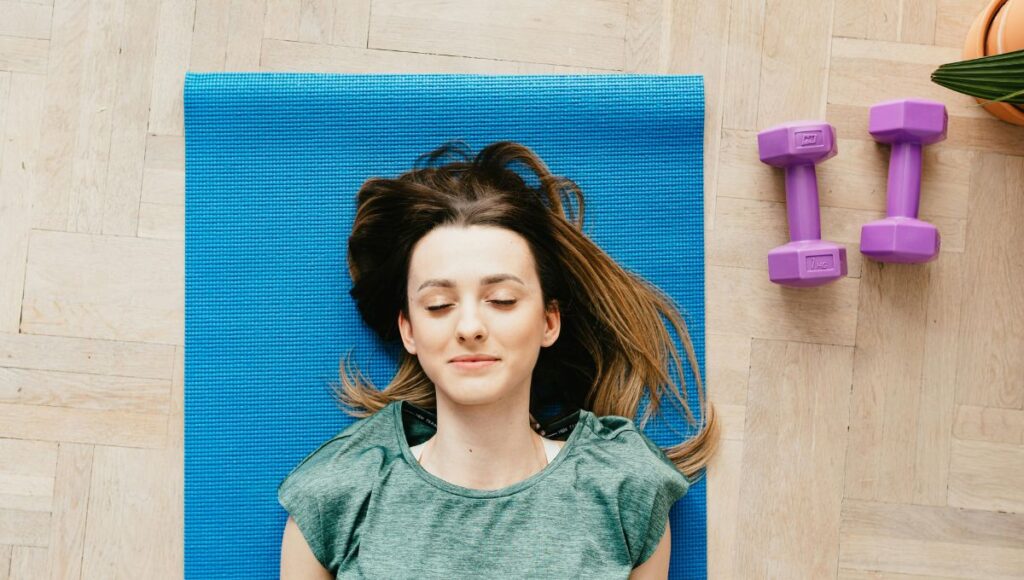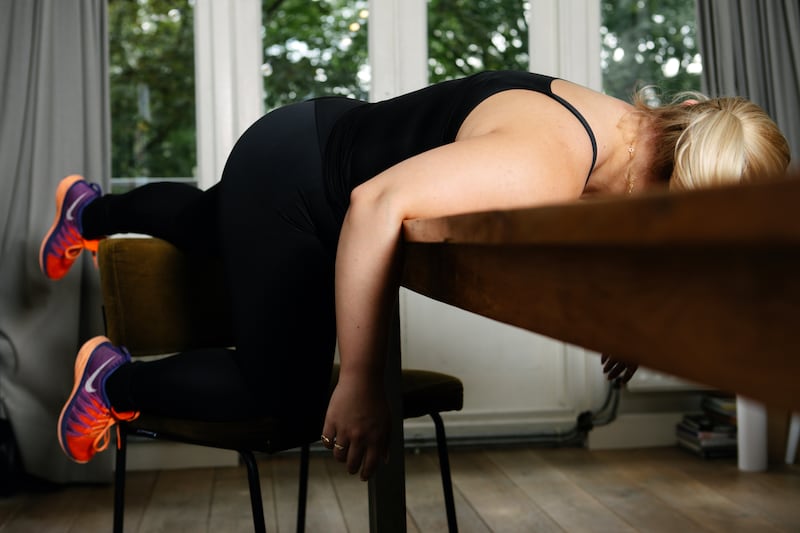Fitness
Denise Austin Reveals Why Walking is Her “Best Medicine”— Plus How to Make Effective Workouts More Fun

Improved heart health, lowered stress, stronger joints, happier moods…the benefits of walking are plentiful! Just ask fitness icon Denise Austin, who is a huge fan of daily walking for physical and mental health. “I am a true believer in walking,” Denise recently told FIRST in an interview for her July cover story. (You can watch a fun behind-the-scenes snippet from this photoshoot in the video above!) “Even if you just fit in a morning walk, you’ll get sunshine and movement — and it’s so good for your overall well-being.”
What’s more, recent research reveals you can multiply the benefits of walking by simply walking with loved ones. The fitness trend of “wellness walks” is popular right now — and they’re something Denise swears by. Keep reading for more easy walking tips! For additional expert workout tips, grab the latest summer issue of Denise’s Fit Over 50 magazine here or order a copy of her latest cover story in FIRST. And keep an eye out for the September 23 issue of FIRST, which features even more walking advice from Denise, and the surprising way you can power up your daily stroll to make it healthier!
Denise Austin’s walking exercise tips
Denise’s go-to combination when it comes to walking: Walk and talk! “Walking is always the best medicine…period,” Denise tells FIRST. “It makes you feel good, keeps you fit and improves your mood. If you can get out for just 15 minutes in the morning, it sets your day up in a nice way.”
But to expand on these benefits even more, she says all you need to do is schedule a walk with a friend or loved one. “I’ll walk with my sisters, my friends. I also love walking with my daughters. We just walk and talk about everything. There’s a sense of freedom and camaraderie that comes from these group walks — and I love that!”
To find a walking or activity meet-up with people your own age, search for walking groups near you on local Facebook groups or on sites and apps like MeetUp. Or you can start your very own neighborhood group with friends and family! No friends nearby to walk with? Call a friend and chat while you stroll!

The benefits of walking and talking
Walking and talking with your loved ones is more than just a good time — it’s actually study-proven to promote longevity. Research has shown that making friends and being social can be beneficial at any age, but it’s especially so in your golden years. In fact, in a study published in Frontiers in Psychology, researchers reviewed studies looking at the relationship between adult friendships and well-being and found that both are vital to our physical and mental health and overall longevity. Not only does socializing lower depression, anxiety and stress, it also boosts overall life satisfaction. And it can help you lose weight!
Denise uses these group walks as something social to look forward to each week. Her routine? “On Sundays, I call my sisters or my girlfriends to see who’s around for the upcoming week and then I schedule it. We all catch up on our long walks and it feels great,” she says. “I’m a big believer in friendship walks! It’s such a great bonding experience. When you’re out on a walk you just talk and I love it. The physical benefits of walking are so beneficial, but the mental benefits are just as impressive. I always say walking is gymnastics for the mind!”
Denise’s favorite walking shoes
Denise loves helping women look and feel their best. And her most recent venture taps right into her love of walking! “Collaborating with Easy Spirit on a line of fitness sneakers has been a great experience! The reason I chose Easy Spirit is because they care about women’s feet, they really think about comfort and they are affordable,” says Denise. “We had the best meetings with all the women designers prior to collaborating. Like me, they’ve done it for 40 years, and I just thought that was really cool. I even get to be a part of the design process where we sit and think about why a woman needs a good walking shoe! They make walking even more fun.” To check out Denise’s collection, visit EasySpirit.com.
For more information and wellness tips, pick up the summer issue of Fit Over 50 at grocery stores and on newsstands now!

Fitness
The Importance of Consistent Exercise for Mental Health | BOXROX

Exercise has long been recognized for its physical health benefits, such as improving cardiovascular fitness, building muscle strength, and enhancing flexibility. However, in recent years, there has been a growing body of research highlighting the profound impact of consistent exercise on mental health. Regular physical activity is not only a powerful tool for preventing and managing mental health conditions but also a vital component of overall well-being.
This article delves into the importance of consistent exercise for mental health, examining the scientific evidence, the mechanisms involved, and practical recommendations for integrating exercise into daily life.
Understanding Mental Health and Its Challenges
Defining Mental Health
Mental health refers to a person’s emotional, psychological, and social well-being. It encompasses how individuals think, feel, and behave in their daily lives. Good mental health is essential for effective functioning and coping with the stresses of life. It is also crucial for building healthy relationships and making meaningful contributions to society. Mental health is not merely the absence of mental illness; it is a dynamic state that can fluctuate over time.
Prevalence of Mental Health Disorders
Mental health disorders are widespread and affect individuals of all ages and backgrounds. According to the World Health Organization (WHO), approximately 1 in 4 people worldwide will experience a mental health disorder at some point in their lives (World Health Organization, 2022). Common mental health disorders include depression, anxiety, bipolar disorder, schizophrenia, and substance use disorders.
Exercise Superior than Medicine to Manage Depression, Study Finds
Challenges in Mental Health Care
Despite the high prevalence of mental health disorders, many individuals do not receive the care they need. Stigma, lack of access to mental health services, and insufficient funding for mental health care are significant barriers to treatment. Moreover, the COVID-19 pandemic has exacerbated mental health challenges, leading to increased rates of anxiety, depression, and stress-related disorders (Czeisler et al., 2020).
The Science Behind Exercise and Mental Health
Exercise as a Preventive Measure
Regular exercise has been shown to reduce the risk of developing mental health disorders. A large cohort study published in the American Journal of Psychiatry found that individuals who engaged in at least one hour of physical activity per week had a lower risk of developing depression compared to those who did not exercise (Harvey et al., 2018). The study followed over 33,000 adults for 11 years, highlighting the long-term protective effects of exercise on mental health.
12 Must-Have Exercises In Your Training Program
Exercise as a Treatment for Mental Health Disorders
Exercise is also an effective treatment for various mental health disorders. A meta-analysis of 49 studies published in the Journal of Clinical Psychiatry found that exercise significantly reduced symptoms of depression, anxiety, and stress-related disorders (Kvam et al., 2016). The analysis included both aerobic and resistance training, indicating that different types of exercise can benefit mental health.
Mechanisms of Action
Neurotransmitter Regulation
Exercise influences the release and regulation of neurotransmitters, such as serotonin, dopamine, and norepinephrine. These chemicals play a crucial role in mood regulation and are often targeted by pharmacological treatments for mental health disorders. For example, serotonin is known to contribute to feelings of well-being and happiness, while dopamine is associated with motivation and reward. Exercise increases the availability of these neurotransmitters in the brain, enhancing mood and reducing symptoms of depression and anxiety (Dishman & O’Connor, 2009).
Neurogenesis and Brain Plasticity
Exercise promotes neurogenesis, the process of generating new neurons in the brain. This process is particularly important in the hippocampus, a region associated with memory and emotional regulation. A study published in the Journal of Neuroscience demonstrated that exercise increased hippocampal neurogenesis in animal models, leading to improved cognitive function and reduced symptoms of anxiety (van Praag et al., 1999). Additionally, exercise enhances brain plasticity, allowing the brain to adapt and reorganise in response to new experiences and challenges.
Stress Reduction
Exercise reduces the body’s physiological response to stress by decreasing the production of stress hormones, such as cortisol, and increasing the release of endorphins, which are natural mood elevators. Regular physical activity also improves resilience to stress by enhancing the body’s ability to cope with stressful situations (Salmon, 2001). This is particularly relevant in today’s fast-paced world, where stress is a common trigger for mental health disorders.
Inflammation and Immune Function
Chronic inflammation has been linked to the development of mental health disorders, including depression and anxiety. Exercise has anti-inflammatory effects and modulates immune function, reducing the risk of inflammation-related mental health issues (Pedersen, 2017). By lowering levels of pro-inflammatory cytokines, exercise helps create an anti-inflammatory environment that supports mental well-being.
Specific Mental Health Benefits of Consistent Exercise
Depression
Depression is one of the most prevalent mental health disorders, characterised by persistent sadness, loss of interest in activities, and a range of physical and emotional symptoms. Exercise has been shown to be as effective as antidepressant medications and psychotherapy in reducing symptoms of depression, particularly in cases of mild to moderate depression (Blumenthal et al., 2007). A systematic review published in the Cochrane Database of Systematic Reviews found that exercise had a moderate-to-large effect on reducing depressive symptoms (Cooney et al., 2013). The review also highlighted that exercise can be a viable adjunctive treatment for individuals who do not respond to traditional therapies.

Anxiety
Anxiety disorders encompass a range of conditions characterised by excessive worry, fear, and nervousness. Exercise has been shown to reduce symptoms of anxiety through several mechanisms, including the regulation of neurotransmitters, reduction of stress hormones, and promotion of relaxation (Herring et al., 2010). A meta-analysis published in the Depression and Anxiety journal found that both aerobic and resistance exercise significantly reduced symptoms of anxiety in individuals with diagnosed anxiety disorders (Jayakody et al., 2014).
Stress and Resilience
Chronic stress can have detrimental effects on mental health, leading to conditions such as burnout, depression, and anxiety. Exercise is a powerful stress reliever, promoting relaxation and enhancing the body’s ability to cope with stressors (Stults-Kolehmainen & Sinha, 2014). Regular physical activity improves resilience by strengthening the body’s physiological and psychological response to stress, making individuals more adaptable to challenging situations.
Cognitive Function
Exercise has been shown to enhance cognitive function and protect against cognitive decline, particularly in older adults. A study published in the Journal of Alzheimer’s Disease found that individuals who engaged in regular physical activity had a lower risk of developing Alzheimer’s disease and other forms of dementia (Hamer & Chida, 2009). Exercise improves cognitive function by increasing blood flow to the brain, promoting neurogenesis, and enhancing synaptic plasticity. These effects contribute to better memory, attention, and executive function, which are essential for maintaining mental health.
Sleep Quality

Sleep disturbances are common in individuals with mental health disorders and can exacerbate symptoms of depression, anxiety, and stress. Exercise has been shown to improve sleep quality by regulating circadian rhythms, reducing anxiety, and promoting relaxation (Kredlow et al., 2015). A study published in the Journal of Clinical Sleep Medicine found that regular exercise was associated with improved sleep quality and a reduced risk of insomnia (Lang et al., 2016). Better sleep quality, in turn, supports mental health by enhancing mood, cognitive function, and overall well-being.
14 Exercise Myths Debunked by Physical Therapists
Self-Esteem and Body Image
Regular exercise can boost self-esteem and improve body image, particularly in individuals with low self-worth or body dissatisfaction. A meta-analysis published in the Journal of Health Psychology found that exercise interventions had a positive effect on self-esteem, particularly when individuals perceived improvements in physical fitness and body composition (Spence et al., 2005). Enhanced self-esteem and body image contribute to better mental health by reducing symptoms of depression, anxiety, and social withdrawal.
Exercise Recommendations for Mental Health
Types of Exercise
Different types of exercise can benefit mental health, and individuals should choose activities that they enjoy and that fit their preferences and lifestyle. The following are some common types of exercise and their potential mental health benefits:
- Aerobic Exercise: Activities such as walking, running, cycling, and swimming have been shown to reduce symptoms of depression and anxiety and improve overall mood.
- Resistance Training: Strength training exercises, such as weightlifting and bodyweight exercises, can improve self-esteem, reduce symptoms of anxiety, and enhance cognitive function.
- Mind-Body Exercises: Practices such as yoga, tai chi, and qigong combine physical movement with mindfulness and relaxation techniques, reducing stress and promoting mental well-being.
- Recreational Activities: Engaging in recreational activities, such as dancing, hiking, or team sports, can enhance social connections and improve mood.
Frequency and Duration
The frequency and duration of exercise required to achieve mental health benefits can vary depending on individual preferences and goals. The following are general recommendations based on current research:
- Frequency: Engaging in exercise at least three to five times per week is associated with significant mental health benefits (Schuch et al., 2016).
- Duration: Sessions of 30 to 60 minutes of moderate-intensity exercise are typically recommended for optimal mental health benefits (Craft & Perna, 2004).
- Intensity: Both moderate and vigorous-intensity exercise can improve mental health. Individuals should aim to engage in activities that elevate their heart rate and breathing but are still enjoyable and sustainable.
Overcoming Barriers to Exercise

Despite the numerous mental health benefits of exercise, many individuals face barriers that prevent them from engaging in regular physical activity. Common barriers include lack of time, motivation, and access to facilities. The following strategies can help overcome these barriers:
- Goal Setting: Setting realistic and achievable exercise goals can enhance motivation and provide a sense of accomplishment.
- Social Support: Exercising with a friend or joining a group can provide accountability and make exercise more enjoyable.
- Incorporating Physical Activity into Daily Life: Finding opportunities for physical activity throughout the day, such as walking or cycling to work, taking the stairs, or engaging in active hobbies, can make exercise more accessible.
- Mindfulness and Enjoyment: Focusing on the positive aspects of exercise, such as the enjoyment of movement and the opportunity for relaxation, can enhance motivation and adherence.
Special Considerations
Exercise and Mental Health Disorders
While exercise can be an effective treatment for mental health disorders, it may not be sufficient as a standalone treatment for individuals with severe or complex conditions. In such cases, exercise should be integrated into a comprehensive treatment plan that includes psychotherapy, medication, and other interventions. It is essential for individuals with mental health disorders to consult with healthcare professionals before starting an exercise program to ensure that it is safe and appropriate for their needs.
Exercise and Vulnerable Populations
Certain populations, such as older adults, individuals with disabilities, and those with chronic health conditions, may face unique challenges when engaging in exercise. Tailoring exercise programs to accommodate individual needs and limitations is crucial for maximising mental health benefits. Healthcare professionals and exercise specialists can play a vital role in designing safe and effective exercise programs for vulnerable populations.
12 Unusual Exercises That Will Get You Ripped
The Role of Technology
Technology can be a valuable tool for promoting exercise and mental health. Fitness apps, wearable devices, and online exercise programs can provide guidance, motivation, and support for individuals seeking to improve their mental well-being through physical activity. Additionally, virtual exercise classes and communities can enhance social connections and provide a sense of belonging, particularly during times of physical distancing.
Conclusion
The importance of consistent exercise for mental health cannot be overstated. Regular physical activity is a powerful tool for preventing and managing mental health disorders, enhancing mood, reducing stress, and improving overall well-being. The scientific evidence supporting the mental health benefits of exercise is robust, highlighting its role as both a preventive measure and an effective treatment for various mental health conditions. By understanding the mechanisms involved and implementing practical strategies for integrating exercise into daily life, individuals can harness the full potential of physical activity to support their mental health and well-being.
Key Takeaways
| Key Takeaway | Description |
|---|---|
| Mental Health Disorders | Common mental health disorders include depression, anxiety, bipolar disorder, schizophrenia, and substance use disorders. |
| Exercise as Prevention and Treatment | Regular exercise reduces the risk of developing mental health disorders and is an effective treatment for depression, anxiety, and stress-related disorders. |
| Neurotransmitter Regulation | Exercise influences neurotransmitter release, enhancing mood and reducing symptoms of mental health disorders. |
| Neurogenesis and Brain Plasticity | Exercise promotes neurogenesis and brain plasticity, improving cognitive function and emotional regulation. |
| Stress Reduction | Exercise reduces stress hormones and increases endorphins, improving resilience and stress management. |
| Types of Exercise | Aerobic, resistance, mind-body, and recreational exercises offer mental health benefits. |
| Frequency and Duration | Engaging in exercise 3-5 times per week for 30-60 minutes can improve mental health. |
| Overcoming Barriers | Strategies such as goal setting, social support, and incorporating activity into daily life can enhance exercise adherence. |
| Exercise and Mental Health Disorders | Exercise should be integrated into a comprehensive treatment plan for severe mental health conditions. |
| Exercise and Vulnerable Populations | Tailored exercise programs are essential for accommodating the needs of vulnerable populations. |
| Role of Technology | Technology can promote exercise and mental health through apps, devices, and virtual communities. |
References
Blumenthal, J.A., Babyak, M.A., Doraiswamy, P.M., Watkins, L., Hoffman, B.M., Barbour, K.A., Herman, S., Craighead, W.E., Brosse, A.L., Waugh, R., Hinderliter, A. and Sherwood, A. (2007). Exercise and pharmacotherapy in the treatment of major depressive disorder. Psychosomatic Medicine, 69(7), pp.587-596.
Cooney, G.M., Dwan, K., Greig, C.A., Lawlor, D.A., Rimer, J., Waugh, F.R., McMurdo, M. and Mead, G.E. (2013). Exercise for depression. Cochrane Database of Systematic Reviews, 9.
Craft, L.L. and Perna, F.M. (2004). The benefits of exercise for the clinically depressed. Primary Care Companion to the Journal of Clinical Psychiatry, 6(3), p.104.
Czeisler, M.É., Lane, R.I., Petrosky, E., Wiley, J.F., Christensen, A., Njai, R., Weaver, M.D., Robbins, R., Facer-Childs, E.R., Barger, L.K., Czeisler, C.A., Howard, M.E. and Rajaratnam, S.M.W. (2020). Mental Health, Substance Use, and Suicidal Ideation During the COVID-19 Pandemic — United States, June 24–30, 2020. MMWR Morb Mortal Wkly Rep, 69, pp.1049–1057.
Dishman, R.K. and O’Connor, P.J. (2009). Lessons in exercise neurobiology: the case of endorphins. Mental Health and Physical Activity, 2(1), pp.4-9.
Hamer, M. and Chida, Y. (2009). Physical activity and risk of neurodegenerative disease: a systematic review of prospective evidence. Psychological Medicine, 39(1), pp.3-11.
Harvey, S.B., Øverland, S., Hatch, S.L., Wessely, S., Mykletun, A. and Hotopf, M. (2018). Exercise and the Prevention of Depression: Results of the HUNT Cohort Study. American Journal of Psychiatry, 175(1), pp.28-36.
Herring, M.P., O’Connor, P.J. and Dishman, R.K. (2010). The effect of exercise training on anxiety symptoms among patients: a systematic review. Archives of Internal Medicine, 170(4), pp.321-331.
Jayakody, K., Gunadasa, S. and Hosker, C. (2014). Exercise for anxiety disorders: systematic review. British Journal of Sports Medicine, 48(3), pp.187-196.
Kredlow, M.A., Capozzoli, M.C., Hearon, B.A., Calkins, A.W. and Otto, M.W. (2015). The effects of physical activity on sleep: a meta-analytic review. Journal of Behavioral Medicine, 38(3), pp.427-449.
Kvam, S., Kleppe, C.L., Nordhus, I.H. and Hovland, A. (2016). Exercise as a treatment for depression: A meta-analysis. Journal of Affective Disorders, 202, pp.67-86.
Lang, C., Kalak, N., Brand, S., Holsboer-Trachsler, E., Pühse, U. and Gerber, M. (2016). The relationship between physical activity and sleep from mid adolescence to early adulthood. A systematic review of methodological approaches and meta-analysis. Sleep Medicine Reviews, 28, pp.32-45.
Pedersen, B.K. (2017). Anti-inflammatory effects of exercise: role in diabetes and cardiovascular disease. European Journal of Clinical Investigation, 47(8), pp.600-611.
Salmon, P. (2001). Effects of physical exercise on anxiety, depression, and sensitivity to stress: A unifying theory. Clinical Psychology Review, 21(1), pp.33-61.
Schuch, F.B., Vancampfort, D., Richards, J., Rosenbaum, S., Ward, P.B. and Stubbs, B. (2016). Exercise as a treatment for depression: A meta-analysis adjusting for publication bias. Journal of Psychiatric Research, 77, pp.42-51.
Spence, J.C., McGannon, K.R. and Poon, P. (2005). The effect of exercise on global self-esteem: a quantitative review. Journal of Sport and Exercise Psychology, 27(3), pp.311-334.
Stults-Kolehmainen, M.A. and Sinha, R. (2014). The effects of stress on physical activity and exercise. Sports Medicine, 44(1), pp.81-121.
van Praag, H., Kempermann, G. and Gage, F.H. (1999). Running increases cell proliferation and neurogenesis in the adult mouse dentate gyrus. Nature Neuroscience, 2(3), pp.266-270.
World Health Organization (2022). Mental health: strengthening our response
Was this article helpful?
Fitness
“It's the walking.” How 1 woman lost 25 lbs and transformed her mental health in 6 months

Welcome to Start TODAY. Sign up for our Start TODAY newsletter to receive daily inspiration sent to your inbox — and join us on Instagram!In late 2021, Jessica Miller, then 44, had a physical where she recalls, “Nothing was good. My cholesterol was terrible. My blood pressure was terrible. I needed to lose some weight.”
Her doctor asked if she was thinking about getting any exercise. “I said, ‘I was going to try to do something when I get older,’ and he said, ‘Older is today. It’s knocking. It’s here. Maybe you should jump in on that,’” she tells TODAY.
She says, “He wanted to put me on medication for blood pressure and cholesterol, but I don’t like taking medicine, and I’m not good at remembering to take it. So, he said, ‘Let’s try walking and see how it goes.’”
As a virtual teacher, Miller spends a lot of time sitting every day, and she needed something to counteract her inactivity. She had been what she calls a “stalker” on the Start TODAY Facebook page for a few months, and seeing how group members improved their lives through walking motivated her to give it a try.
Within six months, she:
- Saw significant drops in her blood pressure and cholesterol levels.
- Lost 25 pounds and has maintained that weight.
- Greatly improved her mental health.
Here’s how she did it.
She worked her way up to 10,000 steps a day
Miller was walking almost zero steps: “As many as it takes to get from my desk to the coffee machine.” When she started walking, she didn’t count her steps. She walked for 10 minutes, then 15 and then 20. After that, she started tracking her steps and worked up to 10,000 — sometimes more.
Most days, she wakes up around 5 or 5:30 a.m. and gets her steps in first thing in the morning. She uses audiobooks as motivation — she only plays them when she’s walking. “If I want to hear what happens in the book, I have to be walking to listen to it,” she says.
In the winter, when it’s cold near her Connecticut home, she switches to indoor walking at the mall. She tries to finish 10,000 steps in the morning, but if she doesn’t have time, she walks more in the afternoon or the evening with her boyfriend.
She’s also started walking to places like the grocery store, a friend’s house or a frozen yogurt shop. “I used to think, ‘I’m not walking someplace, that’s weird. I don’t want anyone to see me walking. They’re going to think I can’t drive or something,” she says. “Now I try to do it, and if I walk someplace, I have to walk home. That forces me to walk more.”
She turns to the Start TODAY group for encouragement. “If I don’t feel like doing something, I look on the Facebook page, and people are walking. They have all these other problems, but they’re still getting their steps in. If they can do it, so can I,” she says. “It’s motivating to see so many people going for walks and doing some exercise, and I have friends I’ve met through the page I keep up with.”
Miller also tries to do the Start TODAY monthly challenges, but she says walking has been the constant for her. “I know that’s what helped me,” she says. “I try to eat better, too, but I like to eat. Mostly, it’s the walking.”
In June 2022, she had the opportunity to appear on TODAY with Stephanie Mansour. “I was walking 10,000 steps a day by that time. My cholesterol had gotten better. My blood pressure was lower, and I had lost 25 pounds,” she says.
She kicked a heavy caffeine habit
Miller’s virtual teaching includes motivational classes for young girls from across the U.S. and around the world. “I have to be energetic. They want to talk and socialize. I don’t want them to be bored,” she says.
She turned to coffee for the caffeine boost. But she was overdoing it. She was starting her day with a pot of coffee, then adding mugs from her Keurig throughout the afternoon and evening — 20 cups a day.
She gradually shifted her intake down to about two cups of coffee a day. She had to take it slowly because cutting back too quickly gave her headaches.
First, she mixed regular coffee and decaf 50/50. “I had to trick myself into thinking it was regular, because I can’t tell the difference in the taste,” she says. Once she adjusted to that mix, she transitioned to only decaf in the afternoons and evenings. She also makes iced coffee, which lasts longer, since as the ice melts, it gets watered down.
She drinks a bottle of water before she has her first cup of coffee in the morning. “It’s the worst bottle of water ever, but it helps because then I don’t feel like I need to drink the whole cup of coffee really fast. When I have water first, I’m not as thirsty,” she says.
She also stopped drinking soda and alcohol. She felt like alcohol was affecting her sleep, and she didn’t want all the sugar and empty calories: “It wasn’t helping me with my stress. Exercise was doing a better job with that than sugary margaritas. It was easier to have water and go for a walk.”

Her lifestyle changes improved her mental health
I feel like all that negativity goes away when I’m walking. When I can get my steps in, I can clear my mind, and I feel better.
Jessica miller
Miller didn’t realize how her lifestyle habits were fueling stress, anxiety and negativity. “I didn’t think it was all connected. I just thought I had a lot of anxiety, and I was stressed out and hyper. On top of that, my clothes weren’t fitting, and I felt like I was lazy because I wasn’t working out,” she says. “I feel like all that negativity goes away when I’m walking. When I can get my steps in, I can clear my mind, and I feel better.”
She has noticed how her healthy habits all combine. “Exercising makes me feel better about myself and improves my mood, which makes me not want to eat junk food or drink coffee. I can change my mood by walking, and it changes my whole day. It gives me a chance to expend some energy and feel good about myself. Starting my day doing something positive makes my whole day better. It all comes together in a cycle.”
Her improved mental health is also helping her come to terms with aging and the changes that it can bring: “Losing the weight helps me feel better. I feel like I have 20 pounds to go, but that’s because I’m comparing myself to Jessica in 1995. I have to remind myself that I’m not going to look like I did when I was 16. I’m almost 50, and I need to put my expectations in perspective.”
Fitness
Exercise is great, but are you resting too little or too much?

Keeping fit requires consistency, motivation and discipline – establishing a routine and sticking with it. But building fitness also involves regularly breaking that routine and getting enough rest. Choosing when not to work out can be as important as the exercise itself.
“Recovery is part of the process,” says Justin Santos, a head coach at the Academy of Lions, a fitness club in Toronto. “Neglecting rest is just as bad as skipping out on a month’s worth of training.”
Getting fit is a cycle of fatigue and repair. And as we adapt, our bodies become stronger, faster and more powerful.
For the average gym-goer, it can be difficult to know exactly how much rest is right. What constitutes a proper rest day?
Are you resting too little or too much?
Exercise causes microscopic tears in our muscle fibres, and as we rest, those fibres are repaired, adapting to become bigger and stronger. This process of adaptation, called super-compensation, is what allows us to run faster, jump higher or lift more weight.
“It’s during the fatigue phase, as the body recovers, that we adapt to the training,” says Giles Warrington, a professor of human performance and innovation at the University of Limerick.
Without adequate rest, the muscles don’t have time to adapt, stalling progress and preventing improvement. But not all fatigue is the same, and neither is all recovery.
[ Take cold dips, eat protein and have more sex: 26 ways to age happily and healthilyOpens in new window ]
For aerobic exercise, such as running or using a skipping rope, “the adaptations are relatively rapid” and could happen overnight, says Warrington. After a light jog, your body will probably be ready for another run the following morning.
For more powerful or explosive power training, “the process of recovery is longer,” and may require a day or two. “Generally speaking, you wouldn’t want to do consecutive days of strength training,” he says.
That said, you don’t need to wait until you’re 100 per cent recovered to work out again, says Santos, especially if you are training toward a goal, such as running a marathon. Some smartwatches and wearables that track the quality of your sleep can score your readiness level, though accuracy varies.
[ How holding still can reduce your blood pressurOpens in new window ]
If you’re just exercising to keep up with the children or age gracefully, he recommends staying at what feels like 80 per cent – where you might feel your previous workout a little, but it doesn’t affect performance. If you’re training for a race or to climb a mountain, he recommends working through some soreness to push your body to improve more quickly. If you want to, say, run a faster 10km, shorter recovery times are better.
If you are exercising three or fewer times per week, you likely don’t need more rest days – you may actually need to work out more often. Try to implement other forms of physical activity into your routine, whether that’s playing a game of frisbee or taking a brisk hike, says Scott Panchik, a former CrossFit Games athlete who now runs a gym. “If you want to get better at something, you need to be getting four or five days in.”
Your rest days should not be completely sedentary. “Recovery doesn’t mean doing absolutely nothing,” says Warrington. Active recovery, which includes low-impact cardio, such as a light jog, long walk or a game like pickleball, has been shown to be very effective at promoting recovery.

Panchik says his recipe is three days on, one day off, followed by two days on, one day off (then repeat). On his days off, he goes for long walks or does light cardio. “I’ve tried resting less,” he says “and it leads to overtraining and to injury”.
Another way to tell if you need more rest days is your overall disposition.
“Mood seems to be the most reliable marker of overtraining,” says Christie Aschwanden, author of Good to Go: What the Athlete in All of Us Can Learn from the Strange Science of Recovery.
If you wake up feeling irritable or cranky, or if you suddenly find yourself reluctant to do a form of exercise you ordinarily love, it’s probably time for a day off.
For people who love working out, it can be tough to take a break. “Rest can be really hard for some people,” says Arielle Loewen, a professional CrossFit athlete. “It can be hard to feel like you’re doing enough. It takes a lot of patience.”
[ Why you should be doing push-ups, and how to master themOpens in new window ]
Forcing yourself to take a rest day is critical to sustaining a long-term exercise habit. “If you don’t take a rest day,” says Loewen, “your body will force you to take one”.
Last, it’s important to get to bed early enough before and after training. “Sleep is probably the most powerful tool in our recovery tool kit,” says Warrington. – This article originally appeared in the New York Times
-

 Mississippi1 week ago
Mississippi1 week agoMSU, Mississippi Academy of Sciences host summer symposium, USDA’s Tucker honored with Presidential Award
-

 Politics1 week ago
Politics1 week agoRepublicans say Schumer must act on voter proof of citizenship bill if Democrat 'really cares about democracy'
-

 Culture1 week ago
Culture1 week agoHe raped a 12-year-old a decade ago. Now, he’s at the Olympics
-
World1 week ago
More right wing with fewer women – a new Parliament compendium
-

 World1 week ago
World1 week agoIsrael says Hezbollah crossed ‘red line’, strikes deep inside Lebanon
-

 News1 week ago
News1 week agoSonya Massey death brings fresh heartache to Breonna Taylor, George Floyd activists
-

 News1 week ago
News1 week agoU.S. men's gymnastics team breaks 16-year Olympic drought with a team bronze
-

 Politics1 week ago
Politics1 week agoSchumer calls on Trump to pick new running mate, claims Vance is 'best thing he's ever done for Democrats'













